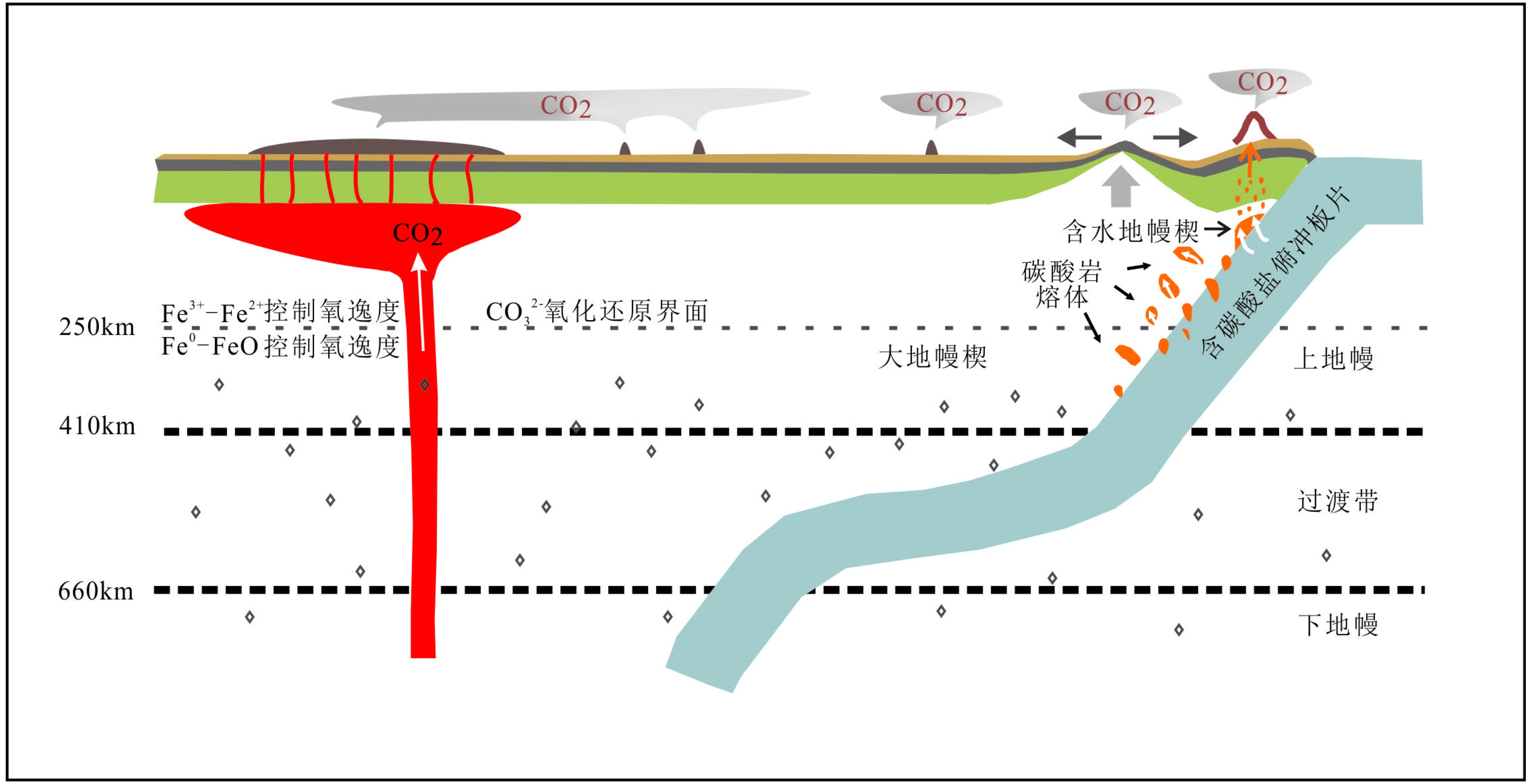Carbon cycle and deep carbon storage during subduction and magamatic processes
-
摘要: 地球内部可能存储了地球上大部分的碳,地球的整个地质演化历史都伴随着碳循环。岩浆过程是重要的CO2释放途径,引起地表碳的增加。板块俯冲起动之后,俯冲带成为地表碳重返地球内部的基本途径。板块俯冲和岩浆过程构成了地表过程和地球内部之间的碳循环,在地质历史时期影响着地表的碳总量,对于宜居地球环境和一些重要矿产资源的形成具有重大意义。然而,相对地表过程的碳循环而言,国际上对深部碳循环的研究程度和取得的认识远远不足。对于地球深部碳的富集机制、赋存部位,以及碳在地球内部各圈层之间的交换规律,还存在很大争议。本文对与深部碳循环密切相关的深部碳储库、岩浆中的碳组成及其对岩浆成因的影响,以及板块俯冲过程中碳行为进行了总结。结果表明,无论是洋中脊玄武岩或洋岛玄武岩,其源区CO2组成都存在高度不均一性;与地幔柱有关的深源板内火山岩相对洋中脊具有异常高的CO2组成,显示深部地幔比上地幔或软流圈更富集碳。地球的地幔转换带(410~660 km)、大陆岩石圈,甚至下地幔可能是重要的碳储库。碳酸岩熔体与岩石圈橄榄岩存在化学不平衡,长期的碳酸岩熔体交代作用可能导致大陆岩石圈是个重要碳储库;地幔转换带的高压还原环境可能使得来自上涌地幔或俯冲板片中的碳以金刚石形式存储。地幔转换带或更深的碳在上涌减压过程中通过氧化还原熔融可以转化为CO2,对地幔初始熔融和板内火山岩的成因(尤其是碱性火山岩)可能具有至关重要的作用。综合认为,导致地球内部富集碳的地质作用最可能是长期板块俯冲,但是目前国内外对与板块俯冲过程相关的碳行为和碳通量估算还存在很大的不足,未来有必要针对岩浆过程的CO2活动行为、俯冲板块中碳的转化行为以及脱碳规律重点开展研究。Abstract: Most of the Earth’s carbon is stored in the deep interior of the Earth, and CO2 plays a key role over the geologic history. Magmatism is a process, which releases CO2 and increases the carbon on the Earth’s surface. Plate subduction is a major process that brings Earth’s surface carbon back to its interior since its initiation globally. Therefore, plate subduction and magmatic processes constitute a deep carbon cycle between the Earth’s surface and interior. The cycle will affect the total amount of carbon of the Earth’s surface and makes contributions to the formation to the livable Earth environment and some important mineral resources. However, in contrast to the carbon cycle in the Earth’s surface system, the knowledge on deep carbon cycle is lacking. There are still controversies about the enrichment mechanism of the deep carbon, the location of its occurrence, and the exchanges of carbon among the solid Earth’s spheres. In this study, we made a thorough review on the deep carbon reservoirs, the carbon composition of magmas and its influences on the genesis of magmas, as well as the geochemical behavior of the carbon during plate subduction. It is recognized that, for the mid-ocean ridge basalts and the ocean island basalts, the CO2 compositions of their mantle sources are highly heterogeneous. Compared to the mid-ocean ridge basalts, the deeper-sourced ocean island basalts have relatively higher concentrations of carbon, indicating that the deep mantle is more enriched in carbon than the shallow upper mantle. The continental lithosphere mantle, transition zone, and even lower mantle may be important reservoirs of carbon. There is a chemical disequilibrium between the carbonated melts and the lithospheric peridotites. The continental lithosphere mantle may be an important carbon reservoir because of the long-term metasomatism of carbonated melts, and the high pressure and strong reducing environment in the mantle transition zone may cause the carbon from the upwelling mantle or subducted slab to be stored in a form of diamond. Carbon in the mantle transition zone or the even deeper sources may be converted to CO2 by redox melting during mantle upwelling and decompression, which plays a key role in the initiation of mantle melting and genesis of the intraplate volcanic rocks (especially for alkali volcanic rocks). It is concluded that the long-term plate subduction in the Earth’s geologic history is most likely the reason that has caused enrichment of carbon in the deep Earth. However, the geochemical behaviors of carbon and the carbon fluxes estimation related to plate subduction remains a subject of debate. In the future study, it is required to focus more on the CO2 activities in the magmatic processes, and the geochemical behaviors (i.e., decarbonation) of carbon in the subducting slab.
-
Keywords:
- magma /
- mantle /
- carbon storage /
- diamond /
- carbon cycle /
- plate subduction
-
碳循环由于其重大环境意义,一直得到国内外广泛重视和研究。长期以来,国内外关于碳循环的研究主要集中在大气圈、水圈和浅地表圈层[1-2]。然而,浅部圈层的碳循环并不会改变地表的碳总量[1,3]。来自地幔的岩浆作用和导致洋壳重返地幔的板块俯冲作用可以直接影响到地表碳总量[2]。因此,深部碳循环可能在改变地表(包括大气)碳组成和塑造宜居地球的过程中起到不可或缺的作用。通常认为,CO2在地幔熔融和岩浆过程中表现为强不相容性和挥发性组分[4],地幔通过部分熔融和岩浆作用向地表迁移了大量CO2。因此,在地质历史时期,火山活动可以明显影响全球碳总量[3]。有研究认为,全球火山作用(洋中脊、岛弧和板内火山)向地表释放的碳通量为约2.2×1012 mol/a[5]。另外,洋底也是一个重要碳汇,大洋俯冲带是直接将地表的碳带入地球深部的场所[1]。在地质历史时期,大洋板块俯冲构成了地表和地球内部之间的大规模物质交换,也很大程度上影响着地幔物质组成和全球碳循环[1-2]。另外,板块俯冲体系也伴有广泛的岛弧和弧后盆地岩浆活动,部分碳通过俯冲过程的脱碳和岩浆作用重返地表[2]。因此,板块俯冲过程是认识地表和深部相互作用及深部碳循环规律的关键所在。地球深部的碳可以参与地幔熔融和岩浆活动,CO2很大程度上改变了岩浆的物理化学性质[6-8],并可以形成高度富集稀土等元素的碳酸盐化岩浆,对一些重要元素的富集和火山岩成因有重要指示意义。
国际上近年来才开始认识到,除了大气和地表以外,地球内部可能也是一个巨大的碳储库。地球内部(地幔+地核)可能存储了大量的碳(占地球20%~80%)[4]。关于地球内部存在大量碳的推论,得到关于地幔深部来源岩浆作用研究和高压模拟实验研究的佐证或支持[5-6,9]。例如,高压实验显示,碳酸岩熔体具有极高的电导率,这可以解释在岩石圈底部出现的高电导率层[10];再如,含CO2系统的高压实验结果显示,CO2对一些低Si岩浆的成因可能起到至关重要的作用,尤其是以碳酸盐矿物为主的火成碳酸岩出现,进一步证实了地球内部存在碳富集带[11]。火成碳酸岩是一种十分少见的岩浆岩,通常具有高度富集的稀土等微量元素,被认为是认识地幔物质组成的重要“探针”[12]。然而,通常出现的火成碳酸岩组分很难直接由地幔熔融形成,这使得碳酸岩成因长期以来都是备受争议的焦点。
尽管目前国际上越来越重视深部碳循环在全球碳循环中的作用,但是关于地球深部碳的富集机制、赋存部位,以及碳在地球内部各圈层之间的交换规律,还存在很大争议[2,9,11,13]。尤其是CO2在岩浆过程中十分活跃[14],岩浆在岩石圈中迁移和火山喷发过程中会将大量的CO2释放。这使得很难根据岩浆组成直接判断CO2对岩浆成因的影响。由于俯冲板块的碳酸盐在一些金属同位素组成上与地幔存在差异,近年来,国内外兴起了通过金属同位素(如Mg、Zn、Ca等)示踪碳循环的大量研究[15-16]。富CO2岩浆的源区,或碳在地幔中的富集部位和赋存形式一直以来都不清楚。高压实验研究和天然火山岩地球化学研究显示,地幔转换带(410~660 km)可以是个重要的碳富集带[16-17];然而,也有研究认为,地球最重要的碳富集带是在浅部岩石圈内(地壳和岩石圈地幔),而不是深部地幔[2,18]。广泛的地质观测和室内实验显示,至少一部分碳可以通过俯冲带进入地幔深部。尽管基于火山岩的岩浆碳通量研究显示,板块携带的一部分碳在俯冲过程中通过脱碳和火山活动重返至地表圈层[2]。一些高温高压实验研究倾向于认为,俯冲板块大部分碳可以通过冷的俯冲带进入地幔,并导致地表碳的减少和地球深部碳的富集[17]。这使得板块俯冲过程中碳的地球化学行为成为认识地球内部碳富集和碳循环规律的重要切入点。
综上,深部碳循环是地球系统科学研究的重要切入点,也是认识地球内部组成和演化的重要方面,近年来已经成为国际研究的热点。近年来的深部碳循环研究,无论在室内高温高压实验、地球物理观测,或是在天然火山岩样品研究方面,都取得了新的认识和进展。这些研究结果对于认识地球内部碳的组成、岩浆过程中碳的地球化学行为等具有重要推动作用。由于板块俯冲和岩浆过程是碳循环的重要载体和途径,为了更好地理解近年来深部碳循环相关研究进展,本文将总结近年来关于深部碳循环与板块俯冲和岩浆过程关系的研究,以期更有效地掌握相关国际进展,针对性地解决关键科学问题。
1. 幔源岩浆的二氧化碳组成
CO2在地幔熔融过程中具有强不相容性,优先富集在熔体中。地质历史时期岩浆活动脱气作用可能是大气CO2组成的重要贡献之一。洋中脊玄武岩代表了地表60%的岩浆通量,也是CO2释放的主要来源。洋中脊玄武岩是来自软流圈地幔部分熔融的产物,其CO2组成可以反映软流圈地幔的组成。然而,玄武岩岩浆在迁移过程中由于减压会导致CO2的饱和,从而在岩浆减压过程中发生脱气作用,使得岩浆初始CO2丢失[19]。为了估算地幔或岩浆源区的CO2组成,通常方法是寻找与CO2在地幔熔融过程中不相容性相似的元素进行对比,例如,通常选择CO2与Ba或Nb的比值作指标。Ba和Nb不是挥发分,在岩浆过程中不受脱气作用影响,因此火山玻璃的CO2/Ba比值变化可以反映岩浆脱气作用是否发生[20]。通常在CO2不饱和的岩浆中,随着Ba的升高CO2会线性升高,因此岩浆不饱和阶段的CO2/Ba比值反映了岩浆源区的CO2的富集程度。高压结晶相内的包裹体可能未经历CO2脱气,可以更好地反映原始岩浆中的CO2组成[21]。
我们统计分析了全球主要洋中脊玄武岩的CO2组成,这些洋中脊包括东太平洋洋隆、大西洋和印度洋洋中脊。对贫CO2和Ba的MORB而言,二者具有较好的相关性,二者之间的比值大致反映了未脱气的原始岩浆的特征(图1)。这些洋中脊玄武岩的CO2含量多数为200~60 μg/g,CO2高于400 μg/g的玄武岩其CO2随Ba变化很小,这说明洋中脊玄武岩CO2达到了饱和(图1)。为了计算软流圈地幔的CO2组成,Cartigny 等根据中大西洋洋中脊玄武岩得出上地幔的CO2/Ba比值为106,从而计算得出上地幔软流圈CO2含量为427±45 μg/g,并根据CO2/Nb比值534,得出上地幔软流圈CO2含量为382±82 μg/g [22]。最近Michael和Graham [19]认为,洋中脊玄武岩的CO2/Ba基本恒定,而CO2/Nb比值随富集程度增加而明显增加,因此CO2/Ba作为计算地幔的CO2含量更为合适,根据CO2/Ba比值获得洋中脊玄武岩CO2平均为2 085 μg/g,其中远离地幔柱热点的N-MORB为1 840 μg/g,计算获得的N-MORB上地幔CO2为183 μg/g。Hauri等通过类似的方法,计算获得全球MORB地幔源区的CO2为182±59 μg/g[23]。尽管如此,一些洋中脊段的玄武岩也是异常富集CO2。如在胡安德富卡洋中脊出现了碎屑式喷发的玄武岩,其橄榄石内熔体包裹体组成显示原始岩浆的CO2含量可以达到3 900 μg/g,其CO2/Ba比值可达180[24]。北极附近的Gakkel洋脊玄武岩的CO2甚至可以达到9 159 μg/g[25]。这些结果表明,洋中脊下部软流圈在CO2组成上也是高度不均一的。实际上,软流圈内CO2组分的不均一性是认识上地幔地球化学不均一性的重要组成部分,也是重要的切入点之一。
![]() 图 1 玄武岩橄榄石熔体包裹体中CO2和Ba含量相关图图中虚线表示CO2与Ba的比值。JFR(Juan de Fuca Ridge)数据引自文献[24,27],Gakkel(Gakkel Ridge)数据引自文献[28,29],MAR(Mid-Atlantic Ridge)数据引自文献[20],Borarhraun数据引自文献[23],Hawaii数据引自文献[30],Azores数据引自文献[31],Iceland数据引自文献[21]Figure 1. Plot of CO2 content vs. Ba abundance for melt inclusions from a basalt olivineDashed lines show constant CO2/Ba ratios. The data of JRF(Juan de Fuca Ridge) is from references[24,27], the data of Gakkel(Gakkle Ridge) from references[28,29], the data of MAR (Mid-Atlantic Ridge) from reference[20],the data of Borarhraun from reference[23],and the data of Azores from reference[31],the data of Iceland from reference[21]
图 1 玄武岩橄榄石熔体包裹体中CO2和Ba含量相关图图中虚线表示CO2与Ba的比值。JFR(Juan de Fuca Ridge)数据引自文献[24,27],Gakkel(Gakkel Ridge)数据引自文献[28,29],MAR(Mid-Atlantic Ridge)数据引自文献[20],Borarhraun数据引自文献[23],Hawaii数据引自文献[30],Azores数据引自文献[31],Iceland数据引自文献[21]Figure 1. Plot of CO2 content vs. Ba abundance for melt inclusions from a basalt olivineDashed lines show constant CO2/Ba ratios. The data of JRF(Juan de Fuca Ridge) is from references[24,27], the data of Gakkel(Gakkle Ridge) from references[28,29], the data of MAR (Mid-Atlantic Ridge) from reference[20],the data of Borarhraun from reference[23],and the data of Azores from reference[31],the data of Iceland from reference[21]另外,我们也统计了典型洋岛玄武岩橄榄石包裹体的CO2组成,包括冰岛、夏威夷海山链、亚速尔海山链(图1),结果表明,大部分洋岛玄武岩的CO2与Ba相关性不好,例如夏威夷的Ba变化不大,而CO2变化范围较大,这些反映了CO2饱和后的脱气作用影响(图1)。Anderson和Poland对夏威夷玄武岩展开研究,发现夏威夷玄武岩源区地幔的CO2为962 μg/g,远高于MORB的地幔源区(约400 μg/g)[26]。Miller等对来自冰岛的玄武岩熔体包裹体研究,发现熔体包裹体具有很高的CO2/Ba比值(396±48),计算获得其地幔源区的CO2为>690 μg/g,计算获得其富集地幔端元的CO2为1 350±350 μg/g[21]。这个估计值几乎高出MORB亏损地幔的10倍。实际上,大多数研究都认为,洋岛玄武岩普遍具有比洋中脊玄武岩高的CO2/Ba比值。一般洋岛玄武岩起源于软流圈之下更深的地幔源区,达到下地幔甚至核幔边界深部,这说明软流圈以下的深部地幔相对浅部地幔是一个更为重要的碳储库。
2. 深部碳富集带
2.1 地幔转换带
固体地球科学研究中,对上地幔底部250 km(410~660 km)厚度范围的认识是上地幔研究中认识最浅薄的(图2)[16]。这里是上、下地幔的过渡带,存在密度差异,这使得俯冲板块可能较长时间(如100 Ma)停留在转换带附近。地球物理层析成像往往在转换带附近探测到速度异常,可能代表了俯冲板片的残留。例如,在俯冲带众多的西太平洋和中国大陆东部下部被认为存在俯冲残留的古太平洋板块[32-33]。板块俯冲可能将大洋板块的一部分碳酸盐带入到地幔深部(图2)[16]。携带碳酸盐的俯冲板片很可能在上地幔底部(或地幔转换带)发生低程度部分熔融,这就会产生富集CO2的碳酸盐熔体,并与俯冲板片分离[17]。分离出来的碳酸盐熔体可能在上地幔深部汇集,构成低速异常。另一方面,高温高压实验研究认为,地幔橄榄岩在高压下(>20 GPa)可以产生还原环境,这是由于其中的Fe2+在高压下会发生歧化反应,并产生一定的Fe0(图2)[34]。如果碳酸盐熔体从板片中脱离出来,会与周围还原性Fe0发生反应形成金刚石,将碳以金刚石形式固定在地幔转换带。地幔转换带接受越多的俯冲板块,就可能聚集越多的碳(金刚石形式)。
另一方面,地幔转换带富集的碳也可能因为板块俯冲之外的因素而获得。由于金刚石在上地幔底部和下地幔中可以稳定存在,而金刚石也可能因为早期地幔演化而形成[35]。例如,在地球演化初期的地幔分异过程中,深部还原性地幔中就可以产生金刚石。由于金刚石相对上地幔较高的平均密度而倾向于滞留在上地幔深部,而在下地幔中金刚石具有相对较低的密度,从而倾向于聚集在下地幔的顶部[35]。因此使得原始地幔中产生的金刚石长期停留在地幔转换带附近。
地幔转换带是潜在重要碳储库,得到了来自深部上地幔低程度熔体的进一步佐证。中国东部新生代以来形成了大量的板内火山岩,多为贫硅碱性火山岩[36]。这些低硅的火山岩最可能来源于CO2的参与,因为CO2参与下的地幔熔融可以使得熔体具备低硅的特征。最近关于中国东部新生代板内玄武岩Mg同位素的研究,也显示源区有CO2的作用[16]。俯冲板块携带的碳酸盐具有较轻的Mg同位素比值,这就使得地幔熔融产生的玄武岩熔体携带了再循环碳酸盐的信息。李曙光等发现中国东部普遍具有相对上地幔较低的Mg同位素比值,认为这反映了地幔中存在再循环洋壳来源的碳酸盐[16]。
2.2 岩石圈底部
岩石圈底部可能也是巨大的碳储库[18,37]。碳酸盐化的熔/流体与冷的地幔岩之间是不平衡的,二者之间可以发生交代反应,反应的结果使得碳交代富集于岩石圈之中[38-39]。地幔中的CO2主要由两种方式上涌,一种是对流上地幔,另一种是来自深部的上地幔物质(如地幔柱)。无论是大陆岩石圈还是大洋岩石圈,二者都是由于软流圈冷凝向固态岩石圈转换的结果。在软流圈上部地幔熔融程度较低,富集CO2的熔体或流体,会上涌交代上部的岩石圈。同样,地幔柱上涌的过程中也可以导致岩石圈发生富碳作用,尤其是地幔柱前缘的熔体常携带CO2与岩石圈发生交代反应产生碳酸盐化的岩石圈地幔。这两种来自地幔CO2熔体的交代富集作用会由于地质时间而逐渐累积,使得越老的岩石圈富集的碳也越多[18]。大陆岩石圈年龄一般在20~30亿年,明显老于目前最老的大洋岩石圈(不超过2亿年)。大陆底部累积的碳总量远超过大洋岩石圈。
大陆下部存在碳富集带可以由广泛的大陆裂谷岩浆活动而体现出来。东非裂谷带是全球最主要的火成碳酸岩分布区,占据全球30%的碳酸岩岩浆[12]。这可能是由于大陆裂解过程中软流圈上涌,将大陆岩石圈底部的碳酸盐化岩浆活化,从而形成碳酸岩岩浆。除了碳酸岩分布以外,东非裂谷断层裂隙内也有广泛的CO2逸出,这也构成了深部碳循环不可或缺的一环[40]。这些现象都说明大陆岩石圈是个重要的碳储库。根据大陆岩石圈的增长和演化,岩石圈下部的碳富集可以分为3个阶段:初始形成过程中的碳富集、大陆演化过程中熔体交代碳富集以及地幔柱穿过岩石圈活动过程的交代富集[18]。据估计,大陆岩石圈初始形成时的碳含量为0.25 Mt C/km3; 在第二阶段,来自对流上地幔的碳可达14~28 Mt C/km3; 在第三阶段,地幔柱活动富集碳可达43 Mt C/km3。作为一个巨大的碳储库,大陆裂解过程可以向地表释放大量CO2。可以推测,地球演化历史过程中大陆裂解和重组可以使得大量碳释放至地表,对地表的总碳以及大气环境可能产生重要影响。
大陆岩石圈中碳的存在形式依赖于岩石圈的厚度和氧逸度。一般而言,地幔岩在较高压力下具有较强的还原性。岩石圈地幔中的碳在>150 km的深度下,可以还原为金刚石[41]。来自深部地幔的板内火山岩中的地幔捕掳体,其中的地幔岩的捕掳体(榴辉岩或橄榄岩)可以含有碳酸盐,也可能含有金刚石。例如,对来自非洲的金伯利岩中出现的金刚石研究,显示岩石圈深部的碳可以大量以金刚石形式存在[42-43]。目前发现的火山岩中的金刚石,基本上都是来自岩石圈,只有极少量是来自岩石圈下的对流地幔[41]。地幔中上涌的碳酸盐化熔体与橄榄岩反应,形成碳酸盐化的地幔岩使得岩石圈浅部碳主要以碳酸盐形式存在。实际上,上涌的碳酸盐熔体/流体可以是氧化性的,也可以是还原性的。一般认为,岩石圈中金刚石的形成大多是由于来自还原性流体(如CH4)与地幔岩的反应。
2.3 下地幔
上地幔上部通常被认为是氧化环境,俯冲板块携带的碳酸盐可能在上地幔中参与熔融,从而返回至地表。常在金刚石中发现的碳酸盐矿物说明,板块俯冲可以将碳酸盐带到至少转换带的深度。然而,关于板块俯冲是否将一部分碳带入下地幔,以及碳在下地幔的存在形式,都还存在很大争议。例如,Kelemenhe和Manning [2] 认为每年俯冲进入地幔的碳为0.0001~52 Mt。尽管如此,冷的板块俯冲有助于将碳酸盐携带至地球更深处,而且越深的地幔越有助于碳酸盐与周围地幔反应,并将碳酸盐转化为金刚石或碳化物。如果这些来自板块俯冲的碳被携带至核幔边界附近,则碳会经历多个相态转变,最终存在形式受地核附近的金属铁等控制[4]。俯冲板块的碳是否进入下地幔深部,这决定于地幔的温度、压力、氧逸度和碳存在形式。在较高的压力下俯冲板块的碳酸钙可以与硅酸盐反应,并转换为更加稳定的菱镁矿(MgCO3),而菱镁矿会随板块俯冲至更大的深度,甚至可能到达下地幔或地核[44]。高压实验显示二价铁在高压下可以通过歧化反应产生Fe0,如果是在下地幔底部和地核附近,则会存在大量金属铁[34,44]。因此,在更大的下地幔深度会使得俯冲碳酸盐转换为金刚石或金属碳化物,从而将其固定到地球深部。
3. CO2对岩浆的成因贡献
CO2是一种具有高度不相容性的组分,无论浅部岩石圈还是地幔转换带的碳,只要参与地幔熔融就会对岩浆组分产生重要影响,并可能对岩浆起源起到关键作用[14]。CO2对地幔深部熔融和岩浆起源可能有着十分重要的意义。有研究认为,软流圈初始熔融开始于300 km以上。软流圈深部(>300 km)的初始熔融深度可能与CO2活动有关。低压下CO2在岩浆中的溶解度很低,幔源岩浆在迁移上升过程中的减压脱气通常使岩浆脱去大部分CO2。近年来,室内高温高压实验在认识CO2对岩浆成因影响机制上做出了巨大贡献。高温高压实验结果显示,在CO2作用下,上地幔深部可以发生低程度部分熔融并形成碳酸岩岩浆,随着熔融程度升高可以演化成为碳酸盐化的硅酸岩岩浆[6,13],这种碳酸盐化的岩浆具有贫硅(硅不饱和)、富磷和轻稀土、亏损高场强元素等特征[7,45]。自然界出现的大部分火成碳酸岩都是以碳酸钙为主,并不符合高温高压实验结果。这些火成碳酸岩常常与碱性火山岩伴生,说明二者之间又具有密不可分的成因联系。尽管火成碳酸岩与碱性玄武岩在主、微量元素组成上存在巨大差异,但在同位素组成上体现出同源性[46],二者之间的成因联系一直没有得到很好的解释。这种火成碳酸岩可能的起源有:直接来自地幔部分熔融,来自岩浆的分离结晶过程,或者来自于母岩浆的液相不混溶[46]。然而,最近中国南海大洋钻探岩芯研究发现,南海海盆扩张停止后在残留脊形成了化学组成符合碳酸盐化硅酸岩岩浆的火山岩,并连续演化为碱性玄武岩[14]。这表明碳酸盐化岩浆演化过程中通过脱去CO2,自身可以直接连续演化成为大洋碱性玄武岩。
大洋板内海山的基底主要由碱性玄武岩组成。通常被认为形成于地幔柱的大洋海山链(如夏威夷海山链[47-48]、卡洛琳海山链[49]等)也常存在碱性玄武岩。虽然CO2常被认为可以构成幔源岩浆的重要组分,但目前发现的大洋火成碳酸岩只有两处(Cape Verde岛和Canary岛[11]),而且大洋碱性玄武岩的CO2含量通常也很低。尽管如此,大洋碱性玄武岩也体现出其源区富集CO2的特征。碱性玄武岩早期结晶的矿物(如橄榄石)中常出现富集CO2的熔融包裹体[50],全岩具有高CaO、低SiO2等与碳酸盐化岩浆相似的特征,以及碱性玄武岩的地幔岩捕掳体中常出现碳酸岩熔体交代的现象[51]等,这说明一些大洋碱性玄武岩的成因与CO2密切相关。目前,国内外关于碳酸盐化岩浆与大洋碱性玄武质岩浆的成因关系的认识仍远为不足。
研究幔源岩浆与CO2的成因联系涉及到CO2的来源。导致地幔CO2富集的最可能原因是大洋板块俯冲[17]。大洋板块(洋壳和沉积物)含有大量沉积碳酸盐,且沉积碳酸盐可以通过较冷的俯冲带进入地幔深部[2,17]。俯冲-再循环的大洋地壳可能是构成地幔不均一性的重要组分,常用来解释一些大洋板内火山的成因。俯冲-再循环洋壳也可能是一些地幔柱的主要来源,可以形成有年龄序列的典型大洋海山链[49,52-53](如夏威夷海山链)。如果大洋板块俯冲将地表碳酸盐带入地幔深部,则CO2在再循环洋壳重返地表并熔融形成海山链的过程中可能起到重要作用。
4. 板块俯冲过程的碳循环
大洋板块是地表过程的重要碳汇,而且是深部碳循环的一个重要碳源(图3)[54]。碳酸钙从海水中沉淀形成大洋沉积物中碳酸盐,大量钙质生物壳体的沉积作用也是大洋碳酸盐的重要来源。另外,大洋地壳中也广泛存在着碳酸盐,主要是由于大洋裂隙中的低温热液流体循环沉淀碳酸盐导致[55]。大洋浅水沉积物中往往存在大量碳酸盐,在碳酸盐补偿深度以浅的碳酸盐可占沉积物体积分数的50%以上。然而,深水沉积物中大部分初始沉积的碳酸盐会溶解,从而使得俯冲沉积物的碳酸盐大量减少。然而,玄武质洋壳裂隙内的碳酸盐随着洋壳年龄增长逐渐增多[54]。据估计,洋壳中的碳酸盐可占洋壳组分的1%~2%,这主要是根据洋壳上层玄武岩岩芯得出的结论[54-55]。因此大洋沉积物和洋壳玄武岩构成了俯冲板块的主要碳载体。目前,对深部岩石圈地幔的碳组成仍存在较多未知(图3)。
大洋板块俯冲是地球深部碳循环的重要一环,板块携带的碳酸盐在俯冲带中的行为很大程度上控制着地球内外的碳收支平衡(图3)[2]。通常认为,以碳酸钙为主的碳酸盐矿物在俯冲带容易发生脱碳反应而释放CO2[56]。一般认为,携带碳酸盐的沉积物在俯冲带先发生脱水再发生部分熔融作用,其中沉积物熔融使得碳酸盐释放出CO2,并参与到岛弧岩浆活动,释放了大部分板块俯冲携带的碳(图3)[57]。实际上,自然界的碳酸盐大多含有一定的Mg或Mn等元素[58-59]。高压实验结果显示,富Mg的碳酸盐相对碳酸钙而言不易在俯冲带发生脱碳反应[44],这可能使得至少一部分含Mg碳酸盐可以通过俯冲带返回至地幔中。另外,俯冲板块年龄和俯冲起始后的不同阶段对碳酸盐的活动性也有较大影响。对于年轻板块俯冲而言,俯冲带具有较高的温度,这使得碳酸盐容易在俯冲带浅部发生熔融和脱碳。对于初始俯冲阶段的俯冲带而言,俯冲碳酸盐也倾向于熔融脱碳,并使其参与到岩浆活动中。对于老的板块俯冲和成熟的冷俯冲带而言,碳酸盐倾向于稳定于更大的深度,甚至被还原为更稳定的单质碳(金刚石)(图2),随着板块俯冲进入地幔深部[60]。
关于板块俯冲携带碳进入地幔转换带的通量,目前还存在很大争议(图3)。但是,如果碳酸盐俯冲进入深部地幔,会很大程度上影响到板块的性质,其中俯冲板块的碳也受到深部地幔中氧逸度变化的影响[34,60-61]。通常来说,俯冲带浅部和上地幔浅部的氧逸度较高(适用于Fe2+/Fe3+氧逸度计)(图2),其中的碳主要以碳酸盐或CO2形式存在。携带碳酸盐的俯冲板片在一定深度会发生部分熔融[17],发生熔融的深度与板片冷热有关,越热的板片发生部分熔融的深度越浅。板片产生的碳酸盐化熔体将与板片分离,分离的碳酸盐化熔体在浅部软流圈深度形成碳酸盐化的硅酸盐熔体,随着深度增加形成碳酸盐熔体。在更大的深度,熔融产生的碳酸盐熔体会与周围的地幔橄榄岩还原环境发生反应(氧逸度受Fe0-FeO控制),并将碳酸盐熔体的碳还原为单质碳[17]。综上,俯冲板片在上地幔深度发生部分熔融后,阻止了碳的进一步俯冲。也有研究认为,俯冲板片在岛弧下部就发生了部分熔融,使得板片来源的CO2参与到岛弧岩浆活动返回地表,或交代岛弧下部的地幔楔。
5. 存在的问题和未来研究展望
由于深部碳循环影响到地表系统的碳总量,并对地球系统科学的建立有着关键作用,因此逐渐得到了地球科学界的广泛重视。室内高温高压实验在深部碳的存在形式、地幔熔融和岩浆过程中碳的地球化学行为等方面做出了重要贡献。由于地质活动过程中的碳非常活跃,通过天然样品研究深部碳循环存在诸多局限性。尽管如此,自然界除了有以钙质火成碳酸岩为主的岩浆岩以外,一些岩浆的形成也需要源区有CO2的参与来解释,岩浆早期结晶矿物中也往往携带了地幔来源的未脱气的碳组分。尤其是一些岩浆或俯冲循环板块中携带了来自深部的金刚石,这些都是开展深部碳循环研究的重要切入点。未来的深部碳循环研究需要将室内高温高压实验与天然样品的研究结合起来,下面列出未来深部碳循环研究存在的主要问题和研究展望:
(1)碱性火山岩与地幔深部CO2的成因联系。低熔融程度有利于富碱金属火山岩的形成,然而,低熔融程度也会使CO2在熔体中高度富集。火成碳酸岩非常少见,但是碱性火山岩很常见,碱性火山岩成因与初始富CO2熔体的成因联系一直存在争议。高度贫硅的碱性火山岩很难由单纯的低熔融程度来解释,导致这些贫硅碱性火山岩形成的原因不仅需要低的熔融程度,更需要CO2在源区起关键作用。未来需要着重研究初始富集CO2的岩浆如何脱碳、如何转化为碱性火山岩。
(2)板块俯冲过程中碳的地球化学行为。碳酸盐矿物在板块俯冲过程中可能会与其他矿物反应而脱碳,也可能参与到板片熔融贡献于岛弧或弧后盆地火山活动,或随着板块俯冲进入地幔深处。俯冲板块中碳的这些行为受到俯冲带热状态、俯冲板块年龄、俯冲带氧逸度等因素的影响。未来需要精确模拟俯冲带的温压条件和氧逸度及其对碳行为的影响。
(3)地幔深部碳的存在形式。如果地幔深部存在一个碳储库,这些碳的存在形式不仅受到温压条件,而且受到氧逸度的影响。近年来,逐渐认识到地幔橄榄岩在高压条件下主要体现为还原环境,可以使得碳以还原态的金刚石(石墨)或金属碳化物形式存在。但是,碳酸盐在金刚石中以包裹体形式的出现说明地幔深部也可能存在氧化态的碳。实际上,地幔体现出的组成不均一性可能反映了再循环组分(如再循环洋壳)的存在,碳在这些复杂的地幔组分影响下的存在形式是未来值得研究的重要科学问题。
(4)火成碳酸岩与大陆岩石圈碳储库之间的成因联系。地球上的火成碳酸岩以碳酸钙为主,而绝大部分火成碳酸岩都出露在陆地上,尤其是在大陆裂谷附近。然而,这些碳酸岩并不符合高压实验研究产生的富Mg原始碳酸岩组成,而更像是来自大陆岩石圈底部的碳储库。大洋中出现的以碳酸钙为主的碳酸岩距离非洲大陆不远,也可能来自大陆底部的岩石圈碳储库。未来需要开展大陆火成碳酸岩的成因研究及其与大陆底部岩石圈碳储成因联系研究。
(5)地幔转换带中的碳储库。地幔转换带是上、下地幔转换的过渡带,大量俯冲板块在此滞留可能也导致了碳的富集。地幔转换带附近的碳很可能通过参与地幔氧化还原熔融而参与到板内岩浆活动中。未来值得通过开展来自滞留板块的板内火山岩成因研究(如中国大陆东部碱性火山岩),来检验地幔转换中碳的作用。
(6)板块俯冲和火山活动导致的碳通量。对于地表系统而言,板块俯冲将地表的碳带入地幔中,而火山活动(洋中脊、岛弧、板内火山活动)增加了地表的碳总量。在地质历史时期,二者导致的地球内外碳通量决定了地球上碳的分布和地表碳总量。目前关于板块俯冲和火山活动对地表碳总量的影响还存在较大争议。未来工作需要针对代表性俯冲带、洋中脊和板内火山开展系统的碳通量研究工作。
-
图 1 玄武岩橄榄石熔体包裹体中CO2和Ba含量相关图
图中虚线表示CO2与Ba的比值。JFR(Juan de Fuca Ridge)数据引自文献[24,27],Gakkel(Gakkel Ridge)数据引自文献[28,29],MAR(Mid-Atlantic Ridge)数据引自文献[20],Borarhraun数据引自文献[23],Hawaii数据引自文献[30],Azores数据引自文献[31],Iceland数据引自文献[21]
Figure 1. Plot of CO2 content vs. Ba abundance for melt inclusions from a basalt olivine
Dashed lines show constant CO2/Ba ratios. The data of JRF(Juan de Fuca Ridge) is from references[24,27], the data of Gakkel(Gakkle Ridge) from references[28,29], the data of MAR (Mid-Atlantic Ridge) from reference[20],the data of Borarhraun from reference[23],and the data of Azores from reference[31],the data of Iceland from reference[21]
图 3 板块俯冲导致的碳循环通量示意图(改编自文献[2])
碳通量数值来自文献[2], 括号内数值来自文献[9] (“-”表示未在研究中估算通量), Dasgupta(2013)[61]提出有5 Mt C/a的通量来自蚀变橄榄岩的俯冲
Figure 3. Model showing fluxes of carbon cycle induced by plate subduction (modified from reference [2])
Values outside the parentheses are from reference [2], values in parentheses from reference [9]("-" indicates that flux was not estimated ), Dasgupta (2013) [61] suggested a value of 5 Mt C/a for subdution of altered peridotite
-
[1] Sleep N H, Zahnle K. Carbon dioxide cycling and implications for climate on ancient Earth [J]. Journal of Geophysical Research: Planets, 2001, 106(E1): 1373-1399. doi: 10.1029/2000JE001247
[2] Kelemen P B, Manning C E. Reevaluating carbon fluxes in subduction zones, what goes down, mostly comes up [J]. Proceedings of the National Academy of Sciences of the United States of America, 2015, 112(30): E3997-E4006. doi: 10.1073/pnas.1507889112
[3] Van Der Meer D G, Zeebe R E, Van Hinsbergen D J J, et al. Plate tectonic controls on atmospheric CO2 levels since the Triassic [J]. Proceedings of the National Academy of Sciences of the United States of America, 2014, 111(12): 4380-4385. doi: 10.1073/pnas.1315657111
[4] Dasgupta R, Walker D. Carbon solubility in core melts in a shallow magma ocean environment and distribution of carbon between the Earth’s core and the mantle [J]. Geochimica et Cosmochimica Acta, 2008, 72(18): 4627-4641. doi: 10.1016/j.gca.2008.06.023
[5] Marty B, Tolstikhin I N. CO2 fluxes from mid-ocean ridges, arcs and plumes [J]. Chemical Geology, 1998, 145(3-4): 233-248. doi: 10.1016/S0009-2541(97)00145-9
[6] Dasgupta R, Hirschmann M M, Smith N D. Water follows carbon: CO2 incites deep silicate melting and dehydration beneath mid-ocean ridges [J]. Geology, 2007, 35(2): 135-138. doi: 10.1130/G22856A.1
[7] Dalou C, Koga K T, Hammouda T, et al. Trace element partitioning between carbonatitic melts and mantle transition zone minerals: implications for the source of carbonatites [J]. Geochimica et Cosmochimica Acta, 2009, 73(1): 239-255. doi: 10.1016/j.gca.2008.09.020
[8] Kono Y, Kenney-Benson C, Hummer D, et al. Ultralow viscosity of carbonate melts at high pressures [J]. Nature Communications, 2014, 5(1): 5091. doi: 10.1038/ncomms6091
[9] Dasgupta R, Hirschmann M M. The deep carbon cycle and melting in Earth's interior [J]. Earth and Planetary Science Letters, 2010, 298(1-2): 1-13. doi: 10.1016/j.jpgl.2010.06.039
[10] Giuliani A, Kamenetsky V S, Phillips D, et al. Nature of alkali-carbonate fluids in the sub-continental lithospheric mantle [J]. Geology, 2012, 40(11): 967-970. doi: 10.1130/G33221.1
[11] Hoernle K, Tilton G, Le Bas M J, et al. Geochemistry of oceanic carbonatites compared with continental carbonatites: mantle recycling of oceanic crustal carbonate [J]. Contributions to Mineralogy and Petrology, 2002, 142(5): 520-542. doi: 10.1007/s004100100308
[12] 宋文磊, 许成, 刘琼, 等. 火成碳酸岩的实验岩石学研究及对地球深部碳循环的意义[J]. 地质论评, 2012, 58(4):726-744. [SONG Wenlei, XU Cheng, LIU Qiong, et al. Experimental petrological study of carbonatite and its significances on the earth deep carbon cycle [J]. Geological Review, 2012, 58(4): 726-744. doi: 10.3969/j.issn.0371-5736.2012.04.014 [13] Dasgupta R, Hirschmann M M, Smith N D. Partial melting experiments of peridotite + CO2 at 3 GPa and genesis of Alkalic Ocean Island basalts [J]. Journal of Petrology, 2007, 48(11): 2093-2124. doi: 10.1093/petrology/egm053
[14] Zhang G L, Chen L H, Jackson M G, et al. Evolution of carbonated melt to alkali basalt in the South China Sea [J]. Nature Geoscience, 2017, 10(3): 229-235. doi: 10.1038/ngeo2877
[15] Liu S A, Wang Z Z, Li S G, et al. Zinc isotope evidence for a large-scale carbonated mantle beneath eastern China [J]. Earth and Planetary Science Letters, 2016, 444: 169-178. doi: 10.1016/j.jpgl.2016.03.051
[16] Li S G, Yang W, Ke S, et al. Deep carbon cycles constrained by a large-scale mantle Mg isotope anomaly in eastern China [J]. National Science Review, 2017, 4(1): 111-120.
[17] Thomson A R, Walter M J, Kohn S C, et al. Slab melting as a barrier to deep carbon subduction [J]. Nature, 2016, 529(7584): 76-79. doi: 10.1038/nature16174
[18] Foley S F, Fischer T P. An essential role for continental rifts and lithosphere in the deep carbon cycle [J]. Nature Geoscience, 2017, 10(12): 897-902. doi: 10.1038/s41561-017-0002-7
[19] Michael P J, Graham D W. The behavior and concentration of CO2 in the suboceanic mantle: inferences from undegassed ocean ridge and ocean island basalts [J]. Lithos, 2015, 236-237: 338-351. doi: 10.1016/j.lithos.2015.08.020
[20] Le Voyer M, Kelley K A, Cottrell E, et al. Heterogeneity in mantle carbon content from CO2-undersaturated basalts [J]. Nature Communications, 2017, 8(1): 14062. doi: 10.1038/ncomms14062
[21] Miller W G R, Maclennan J, Shorttle O, et al. Estimating the carbon content of the deep mantle with Icelandic melt inclusions [J]. Earth and Planetary Science Letters, 2019, 523: 115699. doi: 10.1016/j.jpgl.2019.07.002
[22] Cartigny P, Pineau F, Aubaud C, et al. Towards a consistent mantle carbon flux estimate: Insights from volatile systematics (H2O/Ce, δD, CO2/Nb) in the North Atlantic mantle (14°N and 34°N) [J]. Earth and Planetary Science Letters, 2008, 265(3-4): 672-685. doi: 10.1016/j.jpgl.2007.11.011
[23] Hauri E H, Maclennan J, McKenzie D, et al. CO2 content beneath northern Iceland and the variability of mantle carbon [J]. Geology, 2017, 46(1): 55-58.
[24] Helo C, Longpré M A, Shimizu N, et al. Explosive eruptions at mid-ocean ridges driven by CO2-rich magmas [J]. Nature Geoscience, 2011, 4(4): 260-263. doi: 10.1038/ngeo1104
[25] Koleszar A M, Saal A E, Hauri E H, et al. The volatile contents of the Galapagos plume; evidence for H2O and F open system behavior in melt inclusions [J]. Earth and Planetary Science Letters, 2009, 287(3-4): 442-452. doi: 10.1016/j.jpgl.2009.08.029
[26] Anderson K R, Poland M P. Abundant carbon in the mantle beneath Hawaii [J]. Nature Geoscience, 2017, 10(9): 704-708. doi: 10.1038/ngeo3007
[27] Wanless V D, Shaw A M. Lower crustal crystallization and melt evolution at mid-ocean ridges [J]. Nature Geoscience, 2012, 5(9): 651-655. doi: 10.1038/ngeo1552
[28] Shaw A M, Behn M D, Humphris S E, et al. Deep pooling of low degree melts and volatile fluxes at the 85°E segment of the Gakkel Ridge: evidence from olivine-hosted melt inclusions and glasses [J]. Earth and Planetary Science Letters, 2010, 289(3-4): 311-322. doi: 10.1016/j.jpgl.2009.11.018
[29] Wanless V D, Shaw A M, Behn M D, et al. Magmatic plumbing at Lucky Strike volcano based on olivine‐hosted melt inclusion compositions [J]. Geochemistry, Geophysics, Geosystems, 2015, 16(1): 126-147. doi: 10.1002/2014GC005517
[30] Tucker J M, Hauri E H, Pietruszka A J, et al. A high carbon content of the Hawaiian mantle from olivine-hosted melt inclusions [J]. Geochimica et Cosmochimica Acta, 2019, 254: 156-172. doi: 10.1016/j.gca.2019.04.001
[31] Métrich N, Zanon V, Créon L, et al. Is the ‘Azores hotspot’ a wetspot? Insights from the geochemistry of fluid and melt inclusions in olivine of Pico basalts [J]. Journal of Petrology, 2014, 55(2): 377-393. doi: 10.1093/petrology/egt071
[32] Huang J L, Zhao D P. High‐resolution mantle tomography of China and surrounding regions [J]. Journal of Geophysical Research: Solid Earth, 2006, 111(B9): B09305.
[33] Zhao D P, Tian Y, Lei J S, et al. Seismic image and origin of the Changbai intraplate volcano in East Asia: role of big mantle wedge above the stagnant Pacific slab [J]. Physics of the Earth and Planetary Interiors, 2009, 173(3-4): 197-206. doi: 10.1016/j.pepi.2008.11.009
[34] Rohrbach A, Schmidt M W. Redox freezing and melting in the Earth’s deep mantle resulting from carbon–iron redox coupling [J]. Nature, 2011, 472(7342): 209-212. doi: 10.1038/nature09899
[35] Sun W D, Hawkesworth C J, Yao C, et al. Carbonated mantle domains at the base of the Earth's transition zone [J]. Chemical Geology, 2018, 478: 69-75. doi: 10.1016/j.chemgeo.2017.08.001
[36] Zeng G, Chen L H, Xu X S, et al. Carbonated mantle sources for Cenozoic intra-plate alkaline basalts in Shandong, North China [J]. Chemical Geology, 2010, 273(1-2): 35-45. doi: 10.1016/j.chemgeo.2010.02.009
[37] Ray J S, Pande K, Bhutani R, et al. Age and geochemistry of the Newania dolomite carbonatites, India: implications for the source of primary carbonatite magma [J]. Contributions to Mineralogy and Petrology, 2013, 166(6): 1613-1632. doi: 10.1007/s00410-013-0945-7
[38] Dalton J A, Wood B J. The compositions of primary carbonate melts and their evolution through wallrock reaction in the mantle [J]. Earth and Planetary Science Letters, 1993, 119(4): 511-525. doi: 10.1016/0012-821X(93)90059-I
[39] Russell J K, Porritt L A, Lavallée Y, et al. Kimberlite ascent by assimilation-fuelled buoyancy [J]. Nature, 2012, 481(7381): 352-356. doi: 10.1038/nature10740
[40] Lee H, Muirhead J D, Fischer T P, et al. Massive and prolonged deep carbon emissions associated with continental rifting [J]. Nature Geoscience, 2016, 9(2): 145-149. doi: 10.1038/ngeo2622
[41] Stachel T, Luth R W. Diamond formation—Where, when and how? [J]. Lithos, 2015, 220-223: 200-220. doi: 10.1016/j.lithos.2015.01.028
[42] Eggler D H, Baker D R. Reduced volatiles in the system C–O–H: implications to mantle melting, fluid formation, and diamond genesis[M]//Akimoto S, Manghnani M H. High-Pressure Research in Geophysics[M]. Tokyo: Center for Academic Publications, 1982: 237-250.
[43] Luth R W. Diamonds, eclogites, and the oxidation state of the Earth's mantle [J]. Science, 1993, 261(5117): 66-68. doi: 10.1126/science.261.5117.66
[44] Dorfman S M, Badro J, Nabiei F, et al. Carbonate stability in the reduced lower mantle [J]. Earth and Planetary Science Letters, 2018, 489: 84-91. doi: 10.1016/j.jpgl.2018.02.035
[45] Raffone N, Chazot G, Pin C, et al. Metasomatism in the lithospheric mantle beneath Middle Atlas (Morocco) and the origin of Fe-and Mg-rich wehrlites [J]. Journal of Petrology, 2009, 50(2): 197-249. doi: 10.1093/petrology/egn069
[46] Weidendorfer D, Schmidt M W, Mattsson H B. Fractional crystallization of Si-undersaturated alkaline magmas leading to unmixing of carbonatites on Brava Island (Cape Verde) and a general model of carbonatite genesis in alkaline magma suites [J]. Contributions to Mineralogy and Petrology, 2016, 171(5): 43. doi: 10.1007/s00410-016-1249-5
[47] Clague D A, Dalrymple G B. Age and petrology of alkalic postshield and rejuvenated-stage lava from Kauai, Hawaii [J]. Contributions to Mineralogy and Petrology, 1988, 99(2): 202-218. doi: 10.1007/BF00371461
[48] Phillips E H, Sims K W W, Sherrod D R, et al. Isotopic constraints on the genesis and evolution of basanitic lavas at Haleakala, Island of Maui, Hawaii [J]. Geochimica et Cosmochimica Acta, 2016, 195: 201-225. doi: 10.1016/j.gca.2016.08.017
[49] Jackson M G, Price A A, Blichert-Toft J, et al. Geochemistry of lavas from the Caroline hotspot, Micronesia: evidence for primitive and recycled components in the mantle sources of lavas with moderately elevated 3He/4He [J]. Chemical Geology, 2017, 455: 385-400. doi: 10.1016/j.chemgeo.2016.10.038
[50] Andersen T, Neumann E R. Fluid inclusions in mantle xenoliths [J]. Lithos, 2001, 55(1-4): 301-320. doi: 10.1016/S0024-4937(00)00049-9
[51] Neumann E R, Wulff-Pedersen E, Pearson N J, et al. Mantle xenoliths from Tenerife (Canary Islands): evidence for reactions between mantle peridotites and silicic carbonatite melts inducing Ca metasomatism [J]. Journal of Petrology, 2002, 43(5): 825-857. doi: 10.1093/petrology/43.5.825
[52] Sobolev A V, Hofmann A W, Kuzmin D V, et al. The amount of recycled crust in sources of mantle-derived melts [J]. Science, 2007, 316(5823): 412-417. doi: 10.1126/science.1138113
[53] Hofmann A W, White W M. Mantle plumes from ancient oceanic crust [J]. Earth and Planetary Science Letters, 1982, 57(2): 421-436. doi: 10.1016/0012-821X(82)90161-3
[54] Zhang G L, Smith‐Duque C. Seafloor basalt alteration and chemical change in the ultra thinly sedimented South Pacific [J]. Geochemistry, Geophysics, Geosystems, 2014, 15(7): 3066-3080. doi: 10.1002/2013GC005141
[55] Alt J C, Teagle D A H. The uptake of carbon during alteration of ocean crust [J]. Geochimica et Cosmochimica Acta, 1999, 63(10): 1527-1535. doi: 10.1016/S0016-7037(99)00123-4
[56] Kawamoto T, Yoshikawa M, Kumagai Y, et al. Mantle wedge infiltrated with saline fluids from dehydration and decarbonation of subducting slab [J]. Proceedings of the National Academy of Sciences of the United States of America, 2013, 110(24): 9663-9668. doi: 10.1073/pnas.1302040110
[57] Gorman P J, Kerrick D M, Connolly J A D. Modeling open system metamorphic decarbonation of subducting slabs [J]. Geochemistry, Geophysics, Geosystems, 2006, 7(4): Q04007.
[58] Matsumoto R, Iijima A. Origin and diagenetic evolution of Ca–Mg–Fe carbonates in some coalfields of Japan [J]. Sedimentology, 1981, 28(2): 239-259. doi: 10.1111/j.1365-3091.1981.tb01678.x
[59] Pedersen T F, Price N B. The geochemistry of manganese carbonate in Panama Basin sediments [J]. Geochimica et Cosmochimica Acta, 1982, 46(1): 59-68. doi: 10.1016/0016-7037(82)90290-3
[60] Galvez M E, Beyssac O, Martinez I, et al. Graphite formation by carbonate reduction during subduction [J]. Nature Geoscience, 2013, 6(6): 473-477. doi: 10.1038/ngeo1827
[61] Dasgupta R. Ingassing, storage, and outgassing of terrestrial carbon through geologic time [J]. Reviews in Mineralogy and Geochemistry, 2013, 75(1): 183-229. doi: 10.2138/rmg.2013.75.7
-
期刊类型引用(6)
1. 赵红坤,唐世新,付燕刚,兰瑞烜,赵克强,李晓东,马生明. 海南琼中岩-土体系重金属迁移特征及表土环境质量评价. 岩矿测试. 2024(01): 137-151 .  百度学术
百度学术
2. 姚慧敏,陆天启,钟奕昕,寻看雨,颜巧丽,黄磊. 中国西沙海域永兴岛—七连屿海域鱼体内有机污染物含量特征与来源解析及风险评价. 岩矿测试. 2024(01): 152-165 .  百度学术
百度学术
3. 杨丹丹,刘盛,张志顺,赵彦彦,杨俊,魏浩天,张广璐,孙国静,郭晓强. 南海北部神狐海域不同粒级沉积物的地球化学特征及其物源指示意义. 中国海洋大学学报(自然科学版). 2022(10): 109-126 .  百度学术
百度学术
4. 许莎莎,冯秀丽,冯利,肖晓,刘爽. 南海西北部莺琼陆坡36.6 ka以来的浊流沉积. 海洋地质与第四纪地质. 2020(05): 15-24 .  本站查看
本站查看
5. 王越奇,宋金明,袁华茂,李学刚,李宁,王启栋. 台湾东黑潮主流区近千年来沉积物稀土元素的变化特征与来源. 海洋地质与第四纪地质. 2019(02): 104-113 .  本站查看
本站查看
6. 张爱梅,陈敏,甘华阳,陈秋明,兰斌彬,方琦. 北部湾SO-50柱状沉积物地球化学特征及其物源分析. 海洋学报. 2018(05): 107-117 .  百度学术
百度学术
其他类型引用(3)




 下载:
下载:




